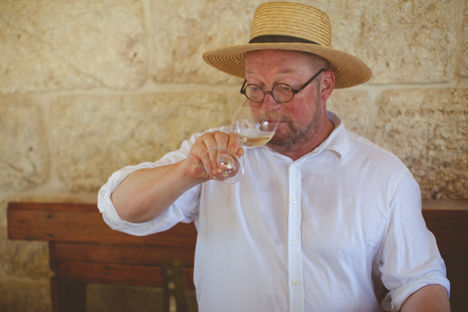
Zhoug and tahini: a road trip around the flavours of Israel
Rachel Walker joins a party of top British chefs as they travel around Israel to discover the country’s thriving food scene.
Zhoug and tahini: a road trip around the flavours of Israel
Rachel Walker joins a party of top British chefs as they travel around Israel to discover the country’s thriving food scene.
José Pizarro is crouching next to an Anglo-Nubian goat, craning his neck for a selfie. It’s a hot sun pounding the Judea Mountains, and the dizzying, midday heat makes the scene between the Spanish chef and the nanny goat seem even more surreal.
It’s the fourth day of a tour round Israel with some of Britain’s top chefs, and this surreal feeling is becoming familiar. The cheesemaker arrives. He’s dressed in white trousers, a sleeveless white shirt with a white beard resting against his chest. ‘Wizard,’ whispers chef Tom Sellers. The cheesemaker dips a long-handled spoon into a jar of labneh, and carefully scrapes the tangy yoghurt onto Fergus Henderson’s outstretched finger. The tasting begins.
Each day on the trip has channelled a dreamlike quality. We eat poached sweet courgettes in chef Eerez Komarovsky’s garden, and fish topped with a blackened pinecone, giving off little wisps of smoke. It feels surreal sharing a kebab with Fergus Henderson on the streets of Tel Aviv and watching chef Pascal Aussignac haggle over the price of a falafel press.
Israel is one of those places where you quickly learn to expect the unexpected though. The young country is only one tenth of the size of Britain and on the same latitude as the Arizona Desert, but it’s astonishingly diverse. Market stalls heave under the weight of tomatoes and peppers, swelled by long hours of sunshine. Citrus and mango trees line the Mediterranean coast, Medjool dates thrive in the arid Arava Valley, and the mountainous north is home to vineyards and orchards.
‘If the raw ingredients were this good in Britain, then my next restaurant would be vegetarian,’ grins Richard Turner, executive chef at the Hawskmoor steak restaurants. ‘I’ll call it Hummousmoor.’
It’s hard to disagree, and it’s part of the reason why Israel is fast becoming a top food destination. As well as the quality ingredients growing locally, there is also a lot of creativity happening in Israel’s kitchens. I’m surprised to discover that it’s a fairly recent movement. Locals explain how it wasn’t long ago that the restaurant scene was dominated by starched French and Italian restaurants. Now chefs look to neighbouring cuisines and local ingredients for inspiration instead.
It makes for a culinary smorgasbord which represents the complicated history of the region. There are over one hundred sushi restaurants in buzzing, youthful Tel Aviv. But on Fridays, the air fills with the scent of sweet challah bread, being baked for Jewish Shabbat. Old sits alongside new. At legendary Jerusalem restaurant, Machneyuda, Israeli folk music blasts out as waiters fling conceptual desserts across the table. In the nearby market, traditional baklava stalls straddle market huts like Beer Bazaar which stocks over 100 Israeli craft beers – the result of a recent boom in microbreweries.
Before we head home, one of the country’s most influential restaurateurs, Ruti Broudo – founder of the R2M restaurant group – hosts us all at her home for an evening which chronicles the country’s history through a medium which we all understand best: food.
Dinner begins with European-style canapés. There are steaming cups of chicken broth with mini dumplings threaded on a cocktail skewer, and chopped liver on challah bread. The ingredients are a nod to the country’s formative years when – in 1948 – refugees arrived from Russia, Poland and Hungary, bringing with them preserved meats and pickles, bagels and brisket.
Then, new aromas start to fill the room. It signals the next phase in Israel’s culinary journey. A chilli-red dish of chermoula fish stew glistens in the candlelight. Bunches of cooked grapes are piled round spiced lamb, which has been slow-cooked until it melts off the bone. Hay-smoked dates accompany a cheeseboard heaving under the weight of all the local varieties.
These are the dishes we’ve eaten throughout the trip. They are the ingredients of the Eastern Mediterranean, woven into modern Middle Eastern dishes. Inspiration comes from Lebanon, Syria, Egypt, and it’s the herb green zhoug and velvet tahinis which make the chefs pause as they take a mouthful. The crisp, birds nest kataifi pastry and thick coffee laced with cardamom.
It’s dark – but there’s a warm night breeze and the mezze-style dinner is in full swing. Glasses are refilled, conversation flows and tongues loosen. ‘We’re so excited you’ve all come,’ says one of the chefs from the R2M group. ‘We want people to understand our country. We want them to know that it’s not all camels and sand, fighting and bombs.’ As the night draws to a close we understand. It’s about so much more.
Photography by Ilan Spira


